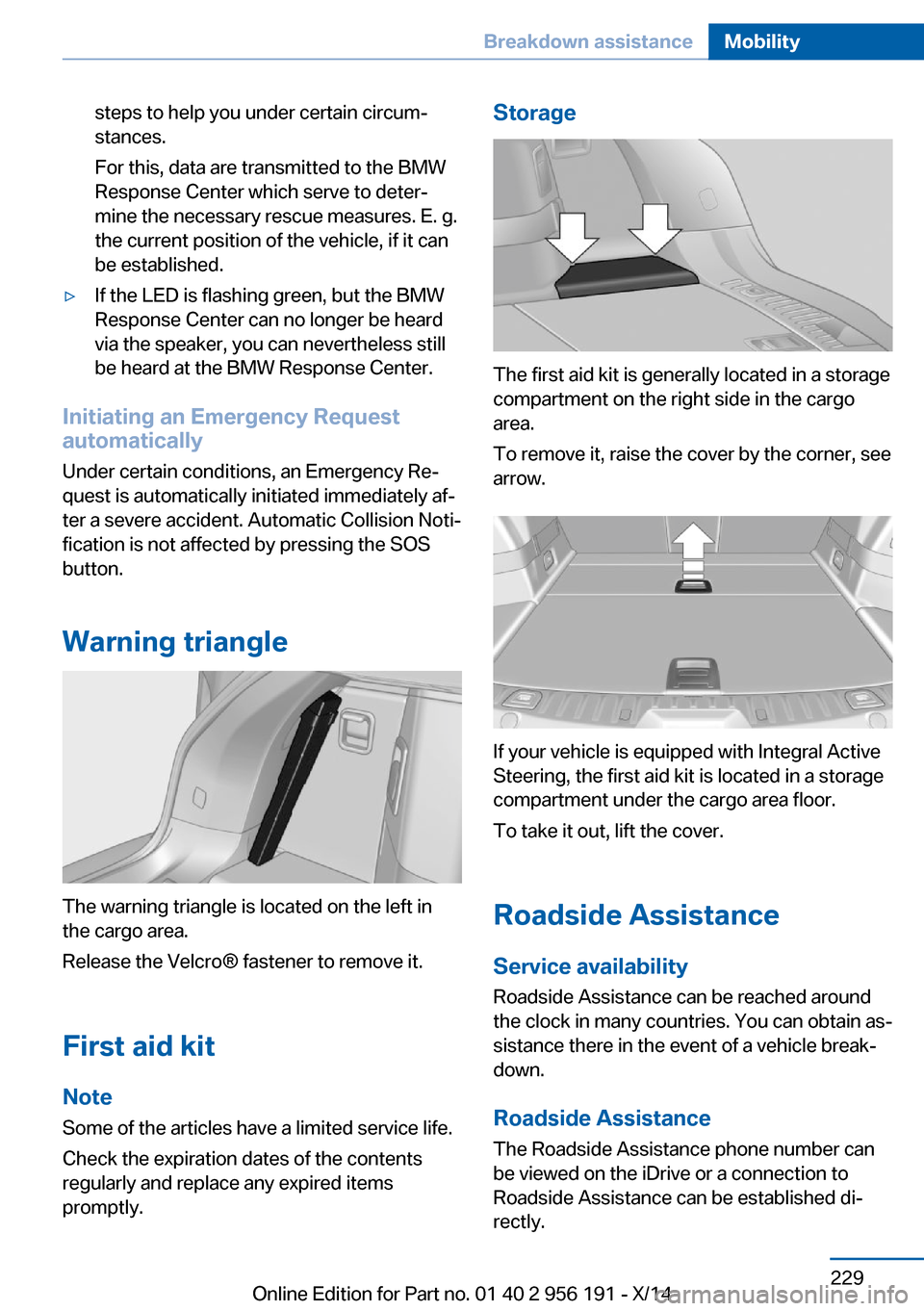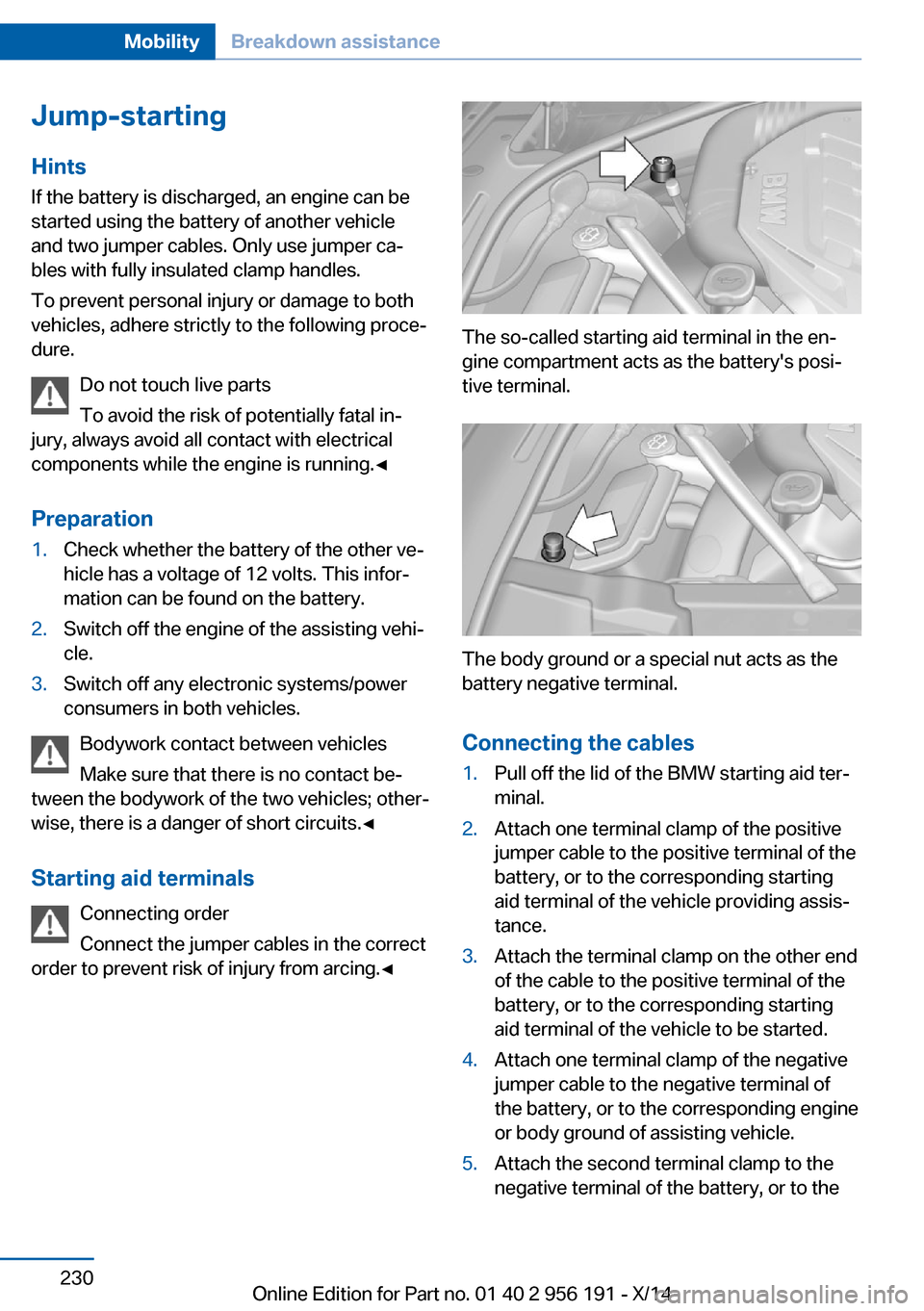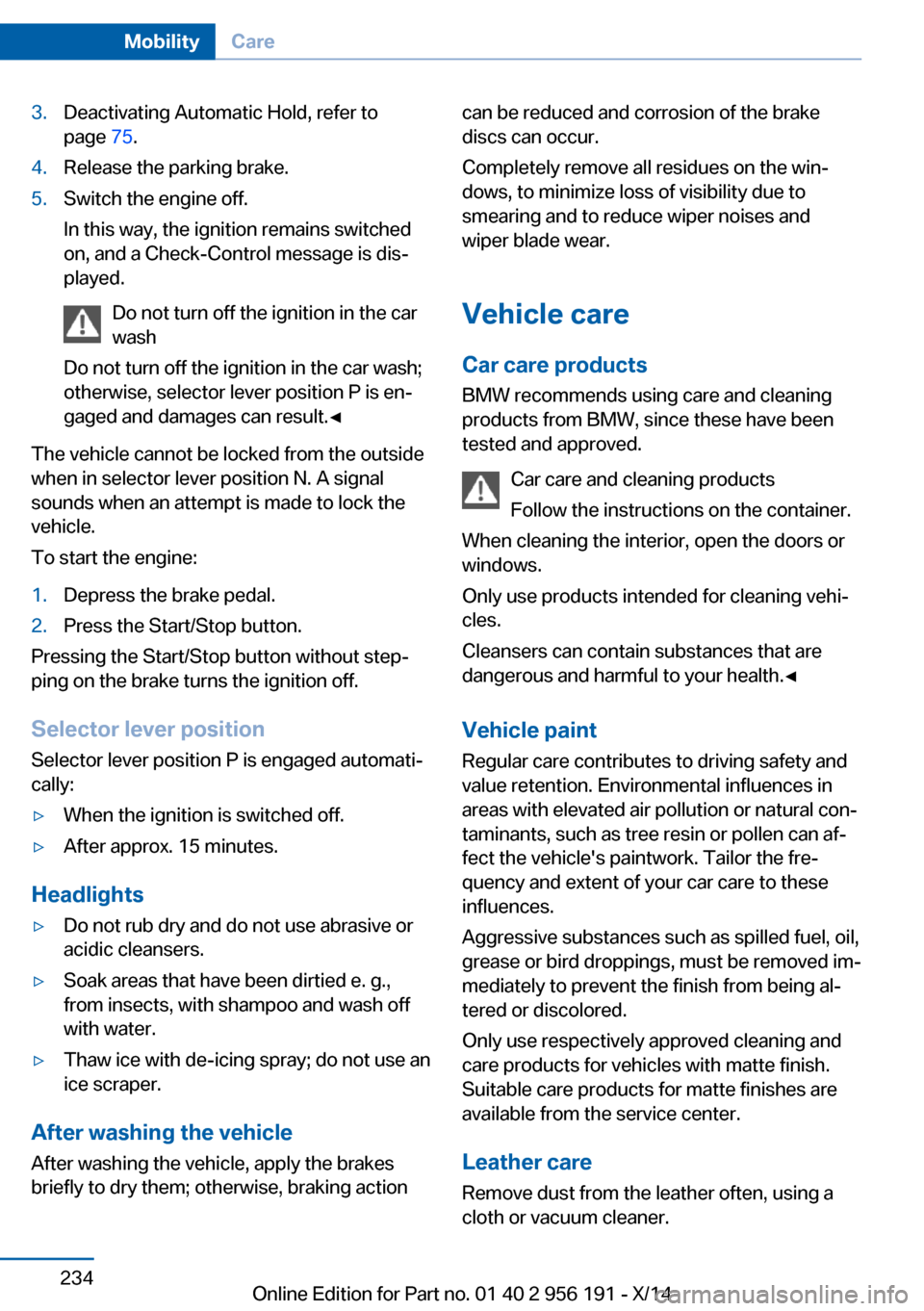2014 BMW 5 SERIES GRAN TURISMO ESP
[x] Cancel search: ESPPage 233 of 259

steps to help you under certain circum‐
stances.
For this, data are transmitted to the BMW
Response Center which serve to deter‐
mine the necessary rescue measures. E. g.
the current position of the vehicle, if it can
be established.▷If the LED is flashing green, but the BMW
Response Center can no longer be heard
via the speaker, you can nevertheless still
be heard at the BMW Response Center.
Initiating an Emergency Request
automatically
Under certain conditions, an Emergency Re‐
quest is automatically initiated immediately af‐
ter a severe accident. Automatic Collision Noti‐
fication is not affected by pressing the SOS
button.
Warning triangle
The warning triangle is located on the left in
the cargo area.
Release the Velcro® fastener to remove it.
First aid kit NoteSome of the articles have a limited service life.
Check the expiration dates of the contents
regularly and replace any expired items
promptly.
Storage
The first aid kit is generally located in a storage
compartment on the right side in the cargo
area.
To remove it, raise the cover by the corner, see
arrow.
If your vehicle is equipped with Integral Active
Steering, the first aid kit is located in a storage
compartment under the cargo area floor.
To take it out, lift the cover.
Roadside Assistance
Service availability Roadside Assistance can be reached around
the clock in many countries. You can obtain as‐
sistance there in the event of a vehicle break‐
down.
Roadside Assistance The Roadside Assistance phone number can
be viewed on the iDrive or a connection to
Roadside Assistance can be established di‐
rectly.
Seite 229Breakdown assistanceMobility229
Online Edition for Part no. 01 40 2 956 191 - X/14
Page 234 of 259

Jump-starting
Hints
If the battery is discharged, an engine can be
started using the battery of another vehicle
and two jumper cables. Only use jumper ca‐
bles with fully insulated clamp handles.
To prevent personal injury or damage to both
vehicles, adhere strictly to the following proce‐
dure.
Do not touch live parts
To avoid the risk of potentially fatal in‐
jury, always avoid all contact with electrical
components while the engine is running.◀
Preparation1.Check whether the battery of the other ve‐
hicle has a voltage of 12 volts. This infor‐
mation can be found on the battery.2.Switch off the engine of the assisting vehi‐
cle.3.Switch off any electronic systems/power
consumers in both vehicles.
Bodywork contact between vehicles
Make sure that there is no contact be‐
tween the bodywork of the two vehicles; other‐
wise, there is a danger of short circuits.◀
Starting aid terminals Connecting order
Connect the jumper cables in the correct
order to prevent risk of injury from arcing.◀
The so-called starting aid terminal in the en‐
gine compartment acts as the battery's posi‐
tive terminal.
The body ground or a special nut acts as the
battery negative terminal.
Connecting the cables
1.Pull off the lid of the BMW starting aid ter‐
minal.2.Attach one terminal clamp of the positive
jumper cable to the positive terminal of the
battery, or to the corresponding starting
aid terminal of the vehicle providing assis‐
tance.3.Attach the terminal clamp on the other end
of the cable to the positive terminal of the
battery, or to the corresponding starting
aid terminal of the vehicle to be started.4.Attach one terminal clamp of the negative
jumper cable to the negative terminal of
the battery, or to the corresponding engine
or body ground of assisting vehicle.5.Attach the second terminal clamp to the
negative terminal of the battery, or to theSeite 230MobilityBreakdown assistance230
Online Edition for Part no. 01 40 2 956 191 - X/14
Page 235 of 259

corresponding engine or body ground of
the vehicle to be started.
Starting the engine
Never use spray fluids to start the engine.
1.Start the engine of the assisting vehicle
and let it run for several minutes at an in‐
creased idle speed.2.Start the engine of the vehicle that is to be
started in the usual way.
If the first starting attempt is not success‐
ful, wait a few minutes before making an‐
other attempt in order to allow the dis‐
charged battery to recharge.3.Let both engines run for several minutes.4.Disconnect the jumper cables in the re‐
verse order.
Check the battery and recharge if needed.
Tow-starting and towing Note Tow-starting and towing
For towing the vehicle turn, switch off the
Intelligent Safety systems; otherwise malfunc‐
tions of the individual braking systems might
lead to accidents.◀
Transporting your vehicle
Note Your vehicle is not permitted to be towed.
Therefore, contact a service center in the
event of a breakdown.
Do not have the vehicle towed
Have your vehicle transported on a load‐
ing platform only; otherwise, damage may oc‐ cur.◀
Tow truck
The vehicle should only be transported on a
loading platform.
Do not lift the vehicle
Do not lift the vehicle by the tow fitting or
body and chassis parts; otherwise, damage
may result.◀
Towing other vehicles
Hints Light towing vehicle
The towing vehicle must not be lighter
than the vehicle being towed; otherwise, it will
not be possible to control the vehicle's re‐
sponse.◀
Attaching the tow bar/tow rope correctly
Attach the tow bar or tow rope to the tow
fitting; connecting it to other vehicle parts may
cause damage.◀
▷Switch on the hazard warning system, de‐
pending on local regulations.▷If the electrical system has failed, clearly
identify the vehicle being towed by placing
a sign or a warning triangle in the rear win‐
dow.
Tow bar
The tow fittings used should be on the same
side on both vehicles.
Seite 231Breakdown assistanceMobility231
Online Edition for Part no. 01 40 2 956 191 - X/14
Page 238 of 259

3.Deactivating Automatic Hold, refer to
page 75.4.Release the parking brake.5.Switch the engine off.
In this way, the ignition remains switched
on, and a Check-Control message is dis‐
played.
Do not turn off the ignition in the car
wash
Do not turn off the ignition in the car wash;
otherwise, selector lever position P is en‐
gaged and damages can result.◀
The vehicle cannot be locked from the outside
when in selector lever position N. A signal
sounds when an attempt is made to lock the
vehicle.
To start the engine:
1.Depress the brake pedal.2.Press the Start/Stop button.
Pressing the Start/Stop button without step‐
ping on the brake turns the ignition off.
Selector lever positionSelector lever position P is engaged automati‐
cally:
▷When the ignition is switched off.▷After approx. 15 minutes.
Headlights
▷Do not rub dry and do not use abrasive or
acidic cleansers.▷Soak areas that have been dirtied e. g.,
from insects, with shampoo and wash off
with water.▷Thaw ice with de-icing spray; do not use an
ice scraper.
After washing the vehicle
After washing the vehicle, apply the brakes
briefly to dry them; otherwise, braking action
can be reduced and corrosion of the brake
discs can occur.
Completely remove all residues on the win‐
dows, to minimize loss of visibility due to
smearing and to reduce wiper noises and
wiper blade wear.
Vehicle care
Car care products BMW recommends using care and cleaning
products from BMW, since these have been
tested and approved.
Car care and cleaning products
Follow the instructions on the container.
When cleaning the interior, open the doors or
windows.
Only use products intended for cleaning vehi‐
cles.
Cleansers can contain substances that are
dangerous and harmful to your health.◀
Vehicle paint
Regular care contributes to driving safety and
value retention. Environmental influences in
areas with elevated air pollution or natural con‐
taminants, such as tree resin or pollen can af‐
fect the vehicle's paintwork. Tailor the fre‐
quency and extent of your car care to these
influences.
Aggressive substances such as spilled fuel, oil,
grease or bird droppings, must be removed im‐
mediately to prevent the finish from being al‐
tered or discolored.
Only use respectively approved cleaning and
care products for vehicles with matte finish.
Suitable care products for matte finishes are
available from the service center.
Leather care
Remove dust from the leather often, using a
cloth or vacuum cleaner.Seite 234MobilityCare234
Online Edition for Part no. 01 40 2 956 191 - X/14
Page 250 of 259

Condensation under the vehi‐cle 186
Condition Based Service CBS 219
Configure driving mode 140
Confirmation signal 47
ConnectedDrive, see user's manual for Navigation, En‐
tertainment and Communi‐
cation
ConnectedDrive Services
Continued driving with a flat tire 111 , 114
Control Display 18
Control Display, settings 98
Controller 18
Control systems, driving sta‐ bility 133
Convenient opening with the remote control 37
Coolant 217
Coolant level 217
Coolant temperature 92
Cooling function 164
Cooling, maximum 164
Cooling system 217
Corrosion on brake discs 186
Cosmetic mirror 171
Cruise control 148
Cruise control, active with Stop & Go 141
Cruise Control, refer to Active Cruise Control 141
Cruising range 92
Cupholder 179
Curb weight 241
Current fuel consumption 93
D
Damage, tires 207
Damping control, dy‐ namic 136
Data, technical 240
Date 92
Daytime running lights 103 Defrosting, refer to Windows,
defrosting 163
Dehumidifying, air 164
Deleting personal data 24
Deletion of personal data 24
Destination distance 97
Digital clock 92
Dimensions 240
Dimmable exterior mirrors 63
Dimmable interior rearview mirror 63
Direction indicator, refer to Turn signals 77
Display, electronic, instru‐ ment cluster 84
Display in windshield 100
Display lighting, refer to In‐ strument lighting 105
Displays 85
Displays, cleaning 236
Disposal, coolant 218
Disposal, vehicle battery 226
Distance control, refer to PDC 150
Distance to destination 97
Divided screen view, split screen 23
Door lock 39
Door lock, refer to Remote control 34
Doors, Automatic Soft Clos‐ ing 40
Downhill control 135
Drive-off assistant 133
Drive-off assistant, refer to DSC 133
Driver assistance, refer to In‐ telligent Safety 115
Driving Assistant, refer to In‐ telligent Safety 115
Driving Dynamics Con‐ trol 138
Driving instructions, break- in 184
Driving mode 138
Driving notes, general 184 Driving stability control sys‐
tems 133
Driving tips 184
DSC Dynamic Stability Con‐ trol 133
DTC Dynamic Traction Con‐ trol 134
Dynamic Damping Con‐ trol 136
Dynamic Drive 136
Dynamic Stability Control DSC 133
Dynamic Traction Control DTC 134
E ECO PRO 191
ECO PRO, bonus range 192
ECO PRO display 191
ECO PRO displays 86
ECO PRO driving mode 191
ECO PRO mode 191
ECO PRO Tip - driving in‐ struction 193
EfficientDynamics 193
Electronic displays, instru‐ ment cluster 84
Electronic oil measure‐ ment 214
Electronic Stability Program ESP, refer to DSC 133
Emergency detection, remote control 35
Emergency release, fuel filler flap 198
Emergency release, parking brake 76
Emergency Request 228
Emergency service, refer to Roadside Assistance 229
Emergency start function, en‐ gine start 35
Emergency unlocking, tail‐ gate 44 Seite 246ReferenceEverything from A to Z246
Online Edition for Part no. 01 40 2 956 191 - X/14
Page 251 of 259

Emergency unlocking, trans‐mission lock 83
Energy Control 93
Energy recovery 93
Engine, automatic reel-off 71
Engine, automatic Start/Stop function 71
Engine compartment 212
Engine compartment, work‐ ing in 212
Engine coolant 217
Engine idling when driving, coasting 194
Engine oil 214
Engine oil, adding 215
Engine oil additives 215
Engine oil change 216
Engine oil filler neck 215
Engine oil temperature 91
Engine oil types, alterna‐ tive 216
Engine oil types, ap‐ proved 216
Engine start during malfunc‐ tion 35
Engine start, jump-start‐ ing 230
Engine start, refer to Starting the engine 71
Engine stop 71
Engine temperature 91
Entering a car wash 233
Equipment, interior 169
Error displays, see Check Control 87
ESP Electronic Stability Pro‐ gram, refer to DSC 133
Exchanging wheels/tires 208
Exhaust system 184
Exterior mirror, automatic dimming feature 63
Exterior mirrors 62
External start 230
External temperature dis‐ play 92 External temperature warn‐
ing 92
Eyes for securing cargo 188
F
Failure message, see Check Control 87
False alarm, refer to Uninten‐ tional alarm 48
Fan, refer to Air flow 163
Filler neck for engine oil 215
Fine wood, care 235
First aid kit 229
Fitting for towing, see tow fit‐ ting 232
Flat tire, changing wheels 225
Flat Tire Monitor FTM 110
Flat tire, Tire Pressure Moni‐ tor TPM 112
Flat tire, warning lamp 111, 113
Flooding 185
Floor carpet, care 236
Floor mats, care 236
Fold-out position, wiper 80
Foot brake 185
Front airbags 107
Front-end collision warning with braking function 119
Front-end collision warning with City Braking func‐
tion 116
Front fog lights 105
Front fog lights, bulb replace‐ ment 224
front-seat passenger airbags, automatic deactivation 109
Front-seat passenger airbags, indicator lamp 109
Front seats 53
FTM Flat Tire Monitor 110
Fuel 200
Fuel consumption, current 93 Fuel consumption, refer to
Average fuel consump‐
tion 97
Fuel filler flap 198
Fuel gauge 91
Fuel lid 198
Fuel quality 200
Fuel recommendation 200
Fuel, tank capacity 242
Fuse 226
G
Garage door opener, refer to Universal Integrated Remote
Control 169
Gasoline 200
Gear change, Steptronic transmission 81
Gear shift indicator 94
General driving notes 184
Glare shield 171
Glass sunroof, refer to Panor‐ amic glass sunroof 51
Glove compartment 177
Gross vehicle weight, ap‐ proved 241
H
Handbrake, refer to Parking brake 73
Hand-held transmitter, alter‐ nating code 170
Hazard warning flashers 228
HDC Hill Descent Con‐ trol 135
Head airbags 107
Headlight control, auto‐ matic 103
Headlight courtesy delay fea‐ ture 102
Headlight courtesy delay fea‐ ture, remote control 47
Headlight courtesy delay fea‐ ture via remote control 39 Seite 247Everything from A to ZReference247
Online Edition for Part no. 01 40 2 956 191 - X/14